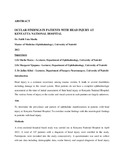| dc.description.abstract | Introduction :Head injury is a common occurrence among trauma victims. It leads to several disabilities including damage to the visual system. Most patients do not have a complete ophthalmologic assessment at the time of initial assessment of their head injury at Kenyatta National Hospital. The various forms of injury to the ocular. and visual system in such patients are largely unknown.
Aim
To determine the prevalence and pattern of ophthalmic manifestations in patients with head injury at Kenyatta National Hospital. To correlate ocular findings with the neurological findings in patients with head injury.
Methods
A cross-sectional hospital based study was carried out at Kenyatta National Hospital in April 2012. A total of 147 patients with a diagnosis of head injury were enrolled in the study. Participants were recruited into the study consecutively. A questionnaire was used to collect relevant data including demographic data, ocular history and surgical diagnosis of head injury including Glasgow Coma Scale. Visual acuity was assessed and a detailed ocular examination carried out. Data was analysed by a Statistical Package for Social Scientists version 17 software.
Results
One hundred and forty-seven patients were studied. Majority of the patients were males (92.5%) while females constituted 7.5%.The mean age of the patients was ,33.7 years. Road traffic accidents (44.9%) and assaults (42.2%) were the commonest causes of head injury. History of ophthalmic complaints and visual acuity were taken in 89 patients who were conscious. Twenty-four patients (27%) had ocular symptoms the most frequent being eye pain in 11 patients (12.4%).
Visual impairment was found in 32 patients (36.0%). Majority of the patients, 57(64.0%) had normal vision. Ocular findings were present in 101 patients (68.7%) with head injury. The commonest findings were in the ocular adnexae with ecchymosis occurring most frequently, in 65 eyes (36.1 %). Pupillary abnormalities occurred in 39 eyes (21.7%), corneal epithelial defects in 30 eyes (16.7%) and optic atrophy in 19 eyes (10.6%). There was a positive correlation between severe head injury (GCS <8) k'cl occurrence of ocular signs though not statistically significant. There was no statistically significant association between. occurrence of ocular signs with the brain CT scan findings and fractures of the skull, orbit and face in patients with head injury.
Conclusion
Ocular findings which lead to visual impairment in head injury patients were present. There was no correlation between occurrence of ocular signs and the neurological findings of patients with head injury.
Recommendation
Early ophthalmological assessment should be undertaken in all patients with head injury. Basic eye care should be carried out by medical personnel caring for the head injury patients pending review by the ophthalmologist. Larger prospective studies need to be carried out to study the effects of head injury a few months after head trauma which should include comprehensive eye assessments. | en_US |

